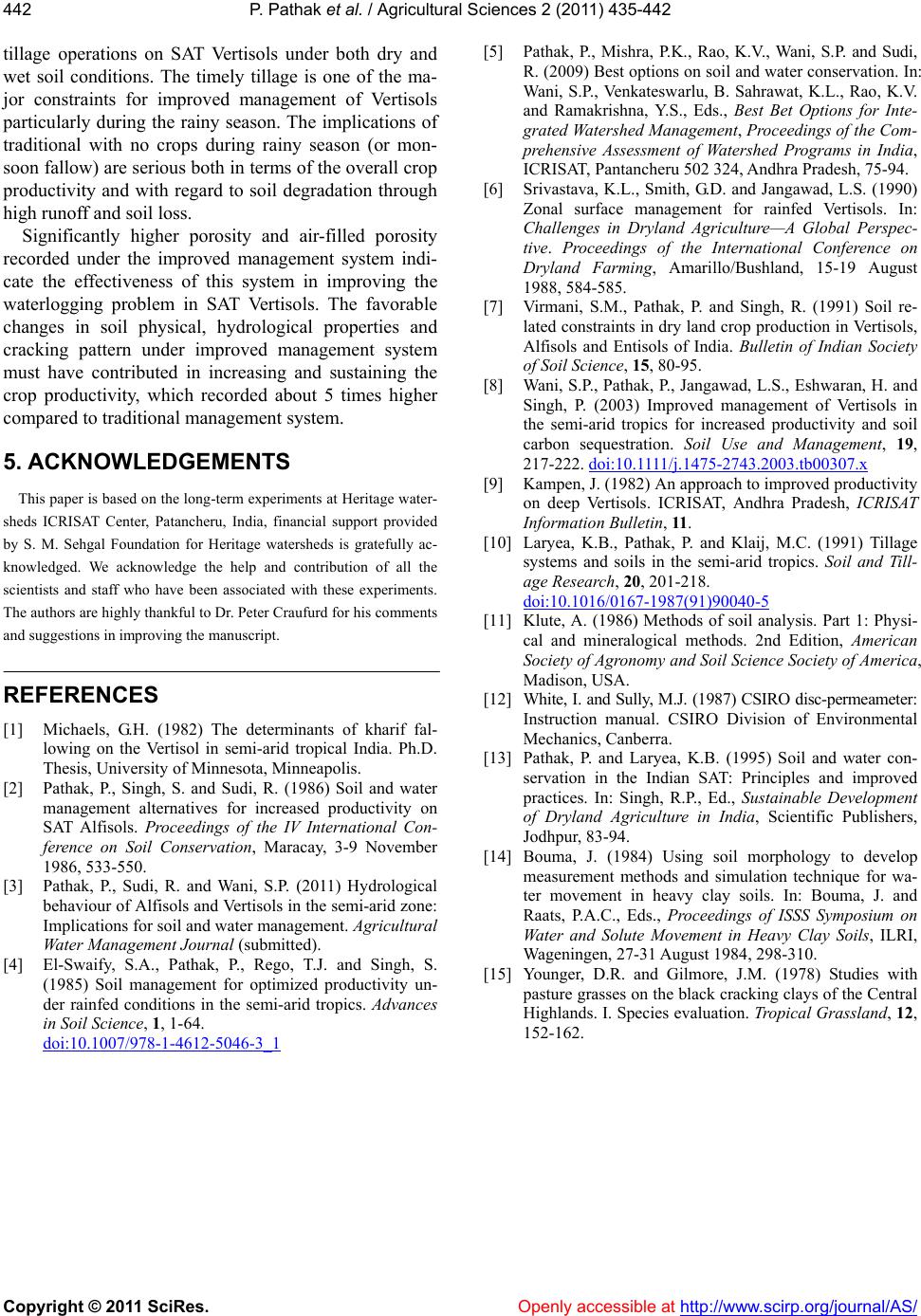
P. Pathak et al. / Agricultural Sciences 2 (2011) 435-442
Copyright © 2011 SciRes. Openly accessible at http://www.scirp.org/journal/AS/
442
tillage operations on SAT Vertisols under both dry and
wet soil conditions. The timely tillage is one of the ma-
jor constraints for improved management of Vertisols
particularly during the rainy season. The implications of
traditional with no crops during rainy season (or mon-
soon fallow) are serious both in terms of the overall crop
productivity and with regard to soil degradation through
high runoff and soil loss.
Significantly higher porosity and air-filled porosity
recorded under the improved management system indi-
cate the effectiveness of this system in improving the
waterlogging problem in SAT Vertisols. The favorable
changes in soil physical, hydrological properties and
cracking pattern under improved management system
must have contributed in increasing and sustaining the
crop productivity, which recorded about 5 times higher
compared to traditional management system.
5. ACKNOWLEDGEMENTS
This paper is based on the long-term experiments at Heritage water-
sheds ICRISAT Center, Patancheru, India, financial support provided
by S. M. Sehgal Foundation for Heritage watersheds is gratefully ac-
knowledged. We acknowledge the help and contribution of all the
scientists and staff who have been associated with these experiments.
The authors are highly thankful to Dr. Peter Craufurd for his comments
and suggestions in improving the manuscript.
REFERENCES
[1] Michaels, G.H. (1982) The determinants of kharif fal-
lowing on the Vertisol in semi-arid tropical India. Ph.D.
Thesis, University of Minnesota, Minneapolis.
[2] Pathak, P., Singh, S. and Sudi, R. (1986) Soil and water
management alternatives for increased productivity on
SAT Alfisols. Proceedings of the IV International Con-
ference on Soil Conservation, Maracay, 3-9 November
1986, 533-550.
[3] Pathak, P., Sudi, R. and Wani, S.P. (2011) Hydrological
behaviour of Alfisols and Vertisols in the semi-arid zone:
Implications for soil and water management. Agricultural
Water Management Journal (submitted).
[4] El-Swaify, S.A., Pathak, P., Rego, T.J. and Singh, S.
(1985) Soil management for optimized productivity un-
der rainfed conditions in the semi-arid tropics. Advances
in Soil Science, 1, 1-64.
doi:10.1007/978-1-4612-5046-3_1
[5] Pathak, P., Mishra, P.K., Rao, K.V., Wani, S.P. and Sudi,
R. (2009) Best options on soil and water conservation. In:
Wani, S.P., Venkateswarlu, B. Sahrawat, K.L., Rao, K.V.
and Ramakrishna, Y.S., Eds., Best Bet Options for Inte-
grated Watershed Management, Proceedings of the Com-
prehensive Assessment of Watershed Programs in India,
ICRISAT, Pantancheru 502 324, Andhra Pradesh, 75-94.
[6] Srivastava, K.L., Smith, G.D. and Jangawad, L.S. (1990)
Zonal surface management for rainfed Vertisols. In:
Challenges in Dryland Agriculture—A Global Perspec-
tive. Proceedings of the International Conference on
Dryland Farming, Amarillo/Bushland, 15-19 August
1988, 584-585.
[7] Virmani, S.M., Pathak, P. and Singh, R. (1991) Soil re-
lated constraints in dry land crop production in Vertisols,
Alfisols and Entisols of India. Bulletin of Indian Society
of Soil Science, 15, 80-95.
[8] Wani, S.P., Pathak, P., Jangawad, L.S., Eshwaran, H. and
Singh, P. (2003) Improved management of Vertisols in
the semi-arid tropics for increased productivity and soil
carbon sequestration. Soil Use and Management, 19,
217-222. doi:10.1111/j.1475-2743.2003.tb00307.x
[9] Kampen, J. (1982) An approach to improved productivity
on deep Vertisols. ICRISAT, Andhra Pradesh, ICRISAT
Information Bulletin, 11 .
[10] Laryea, K.B., Pathak, P. and Klaij, M.C. (1991) Tillage
systems and soils in the semi-arid tropics. Soil and Till-
age Research, 20, 201-218.
doi:10.1016/0167-1987(91)90040-5
[11] Klute, A. (1986) Methods of soil analysis. Part 1: Physi-
cal and mineralogical methods. 2nd Edition, American
Society of Agronomy and Soil Science Society of America,
Madison, USA.
[12] White, I. and Sully, M.J. (1987) CSIRO disc-permeameter:
Instruction manual. CSIRO Division of Environmental
Mechanics, Canberra.
[13] Pathak, P. and Laryea, K.B. (1995) Soil and water con-
servation in the Indian SAT: Principles and improved
practices. In: Singh, R.P., Ed., Sustainable Development
of Dryland Agriculture in India, Scientific Publishers,
Jodhpur, 83-94.
[14] Bouma, J. (1984) Using soil morphology to develop
measurement methods and simulation technique for wa-
ter movement in heavy clay soils. In: Bouma, J. and
Raats, P.A.C., Eds., Proceedings of ISSS Symposium on
Water and Solute Movement in Heavy Clay Soils, ILRI,
Wageningen, 27-31 August 1984, 298-310.
[15] Younger, D.R. and Gilmore, J.M. (1978) Studies with
pasture grasses on the black cracking clays of the Central
Highlands. I. Species evaluation. Tropical Grassland, 12,
152-162.